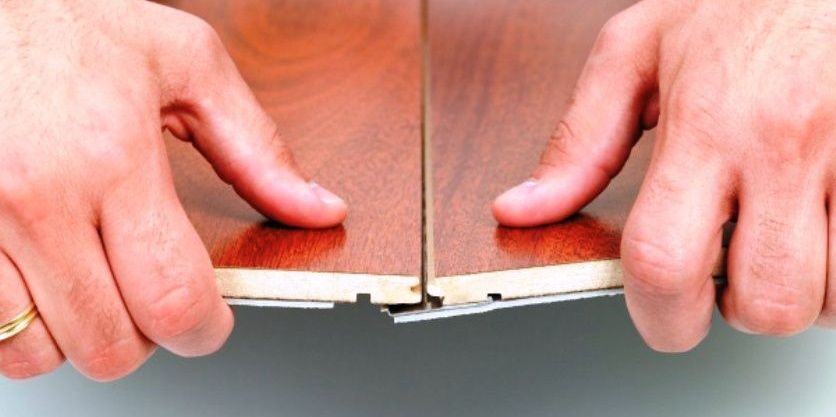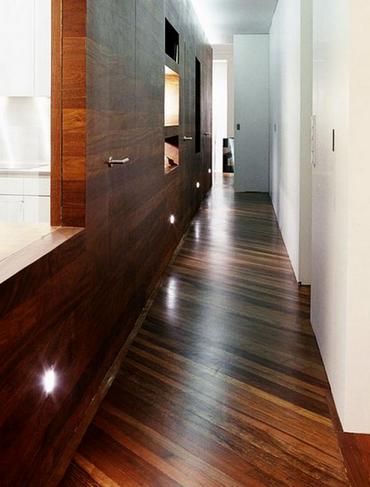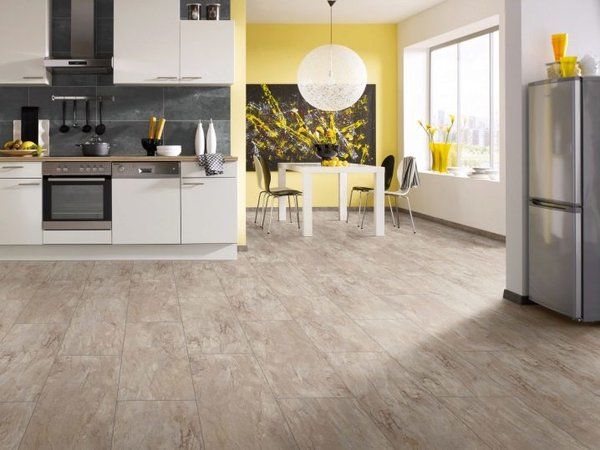Types of laminate locks
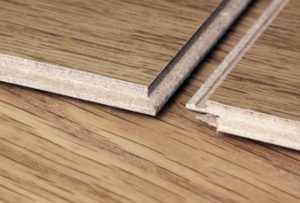 The joints between laminate panels are both the most vulnerable and the strongest part, so when choosing, you need to take care to choose the highest quality and most effective locking system that ensures evenness of the coating and durability in its operation for many years. In addition, choosing the right lock guarantees your floor protection from squeaking and seam discrepancies. The joints between laminate panels are both the most vulnerable and the strongest part, so when choosing, you need to take care to choose the highest quality and most effective locking system that ensures evenness of the coating and durability in its operation for many years.
The joints between laminate panels are both the most vulnerable and the strongest part, so when choosing, you need to take care to choose the highest quality and most effective locking system that ensures evenness of the coating and durability in its operation for many years. In addition, choosing the right lock guarantees your floor protection from squeaking and seam discrepancies. The joints between laminate panels are both the most vulnerable and the strongest part, so when choosing, you need to take care to choose the highest quality and most effective locking system that ensures evenness of the coating and durability in its operation for many years.
In addition, choosing the right lock guarantees your floor protection from squeaking and seam discrepancies. Currently, there are many types of fastenings, so the consumer inevitably faces the question - which ones are better and which is more suitable for his needs? Such requests sometimes include not only durability, strength and evenness, but also the possibility of further dismantling.
The content of the article
What are laminate locks
Before their appearance, floor coverings were fastened together exclusively with the help of adhesives, which was time-consuming, inconvenient and fraught with deterioration in the quality of the coating over time.The invention of glue-free locking technology in the 90s created a real sensation in repair work, as it greatly facilitated and accelerated the installation of panels, and also made it possible to quickly and easily carry out dismantling activities.
What are laminate locks and how do they work? At the edges of the panels there are special latches, or clamps, the shape and material of which vary depending on their type. What they have in common is that fastening occurs mechanically, the so-called floating method, without the need to use any other devices.
Types of laminate locks
In fact, despite the variety of types of locking laminate systems on the market, according to the principle of operation they are divided into only two main groups - Lock and Click, each of which further branches into a variety of types.
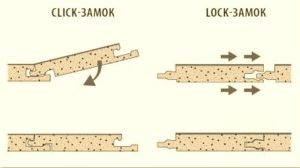 Lock is a simpler and already outdated type of lock, in which the tenon and groove under it are complex figures that complement each other. Installation occurs by horizontally pressing one panel into another until it clicks, ensuring their tight adhesion to each other, while dismantling without destruction will require significant effort. The outer blade, as a rule, is additionally beaten with a wooden hammer for greater reliability. To prevent abrasion and separation of the panels, their locks are treated with sealant or adhesive. Currently, this species accounts for only about 15 percent of the market.
Lock is a simpler and already outdated type of lock, in which the tenon and groove under it are complex figures that complement each other. Installation occurs by horizontally pressing one panel into another until it clicks, ensuring their tight adhesion to each other, while dismantling without destruction will require significant effort. The outer blade, as a rule, is additionally beaten with a wooden hammer for greater reliability. To prevent abrasion and separation of the panels, their locks are treated with sealant or adhesive. Currently, this species accounts for only about 15 percent of the market.
Click - is a more advanced and popular version of the previous option. In addition to the fastening protrusions, the tenon is also supplemented with an additional hook, the shape of which is repeated by the groove.Unlike the Lock system, installation occurs at an angle, then the panel is lowered into a horizontal position until it clicks. You can successfully dismantle such a laminate without damage up to four times.
Types of locks - which one is better
All other types of locks, in one way or another, combine both technologies, or take one of them as a basis and add any additional elements to it. Let's give some examples.
 T-Lock is just an example of combining both options, and the Click system is used during installation. Its main positive quality is maximum strength.
T-Lock is just an example of combining both options, and the Click system is used during installation. Its main positive quality is maximum strength.
- 5G is an offshoot of the Lock system with the addition of a plastic or metal “tongue” for greater connection density. Can be dismantled as easily as possible.
- Megalock - has an end insert, due to which installation is carried out in the shortest possible time. In addition, it is endowed with improved moisture resistance.
- ClickXpress - differs from the classic Click system in that the tenon is rounded at the bottom, which replicates the groove.
- Uniclick is unique in that it can connect both horizontally and at an angle.
aluminum lock is the most reliable version, thanks to which the joints are almost invisible to the eye, and dismantling can be done up to 5 times.
Which one is better? Each consumer will answer this question for himself, assessing the advantages and disadvantages of each type.
As mentioned earlier, the Lock is gradually being phased out of the market because it is more susceptible to wear on the combs with the risk of further gaps, as well as being more dependent on the flatness of the surface than the Click. However, this is a more budget-friendly option, so you will save a lot if you buy it.
The Click system is simpler and more reliable, however, this also affects the cost. Therefore, it’s up to you to decide whether to invest in quality or save on it.
